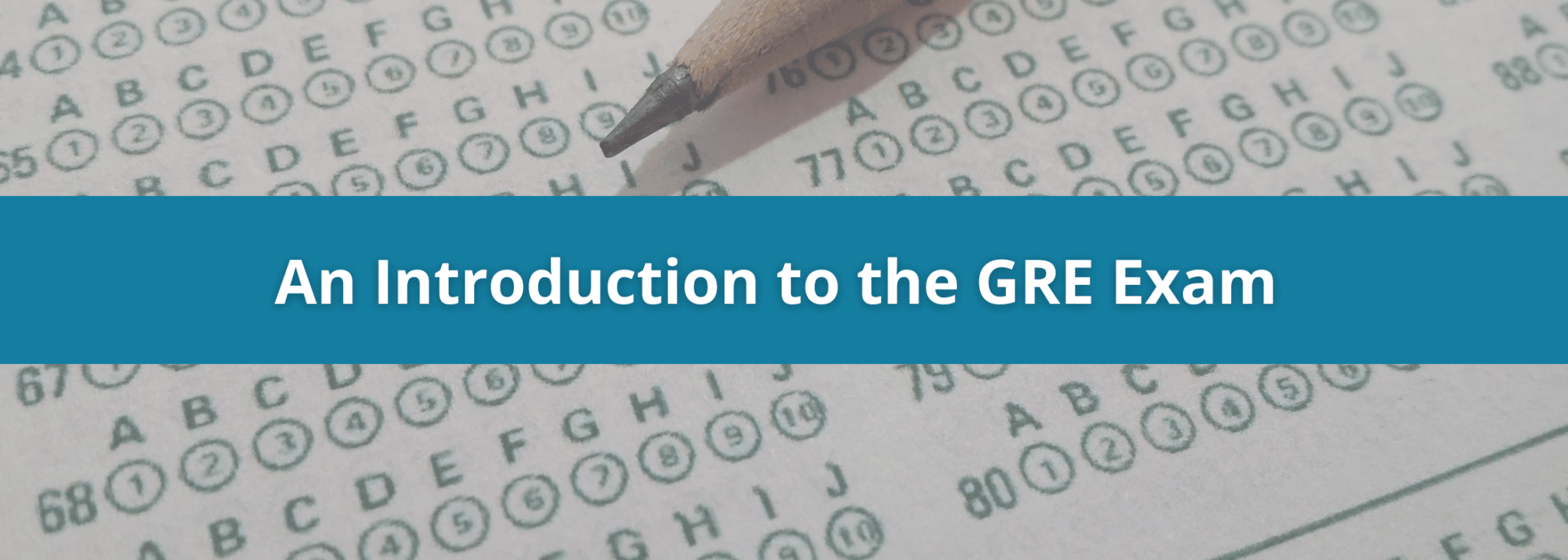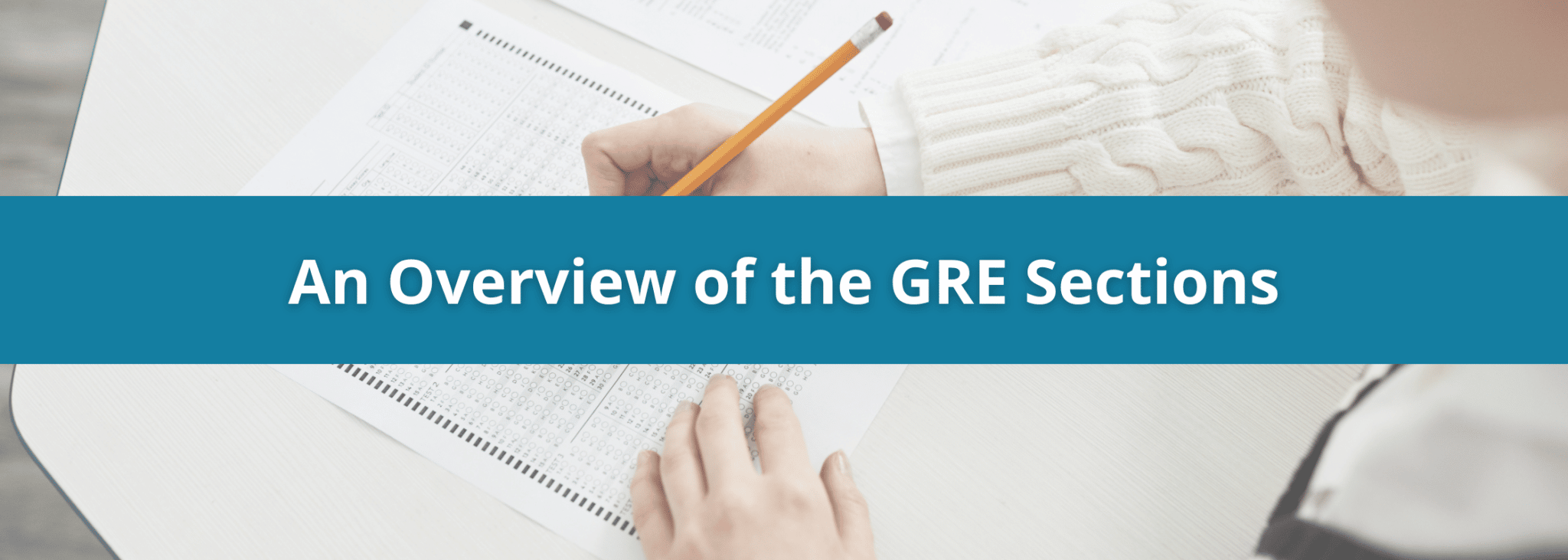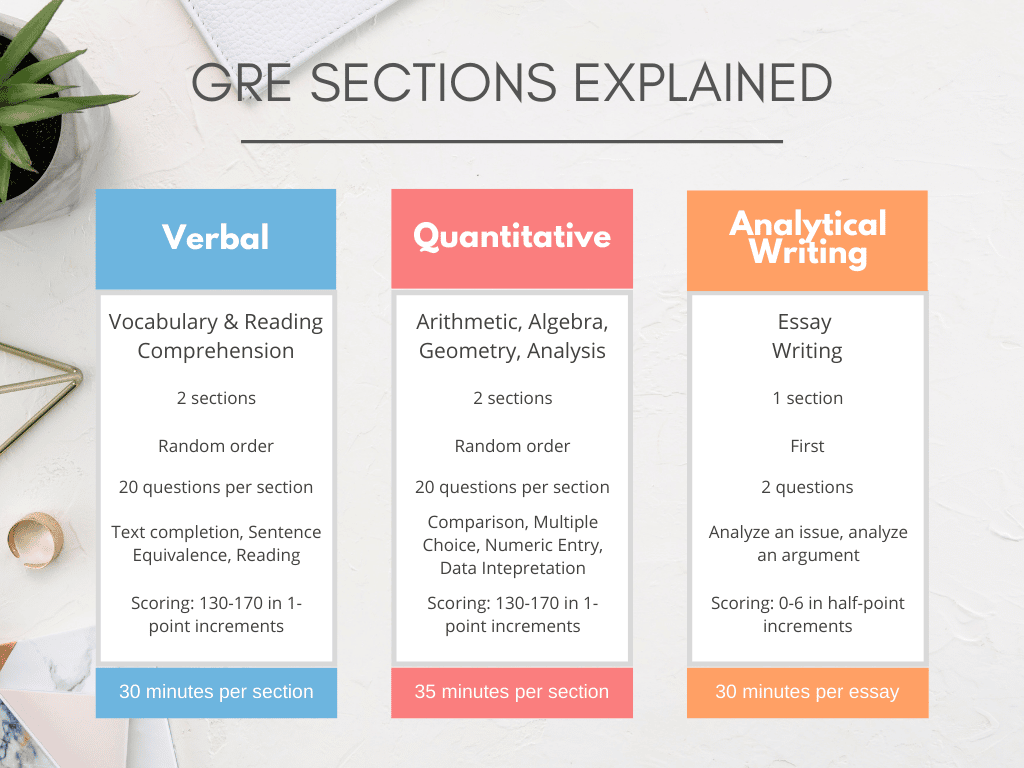For many people, standardized test-taking can be very daunting. Applying to a graduate program or for an MBA is a big commitment, and it’s not to be taken lightly! The GRE test is the perfect assessment to introduce yourself to the structure of the higher education institution you aspire to attend.
So what is the GRE used for? How is it structured? And how should I prepare for it? Out of all the graduate-level exams, the GRE is the most widely used, and often the one students have the most questions about.
The GRE is broken down into three different sections: Analytical Writing, Quantitative Reasoning, and Verbal Reasoning. This post will provide a GRE overview of the most important information for prospective test-takers.
Introduction to the GRE
GRE test preparation involves the Graduate Record Examination General Test or GRE General Test. While various graduate programs may require additional GRE Subject Tests, most GRE prep is focused on the General Test.
As a central component of the graduate school application process, this test is taken by students who have either completed or are close to completing their undergraduate degrees. It is required by nearly every graduate program in the United States, and most students begin their GRE online prep months before their desired test dates. This test consists of many challenging question types found in the most rigorous graduate school programs.
Unlike the paper-based SAT, however, the GRE is a computer-based, section-adaptive exam. Consequently, the GRE format, scoring, and available test dates differ from typical standardized tests. Let’s start from the beginning to set you up for success through your entire test-taking journey.
Where Can I Register for the GRE?
Once you decide on your ideal test date, you can plan it months in advance. The test is offered all year round, but seats are limited per session. You can view the seat availability for your preferred date and location on the ETS website.
When planning your registration date, consider when you need your test scores for your school admissions. You’ll want to give yourself a few months to study, and once your test is complete, you’ll receive your results around five weeks later. Fortunately, you can send your test results directly to the school of your choice.
GRE Scheduling
GRE testers now have two interchangeable options for taking the test: at a traditional test center or in the comfort of their own home. The test is identical in both settings, with only minor logistical differences separating the two.
- GRE At Home is now available permanently.
- GRE At Home is offered everywhere, and the GRE General Test is available worldwide.
- GRE At Home is identical to the computerized Test Center version of the GRE in content, test format, and test length.
- GRE At Home offers the same accommodations as the Test Center version of the test, including extended time, extended breaks, and screen magnification.
- GRE At Home offers the same limitations on test frequency—you can take the GRE General test once every 21 days, up to five times within twelve months. This includes situations in which you have canceled your scores on a test taken previously.
Get all the details of the GRE At Home and test center registration process at the ETS’s website. For a more in-depth comparison of the two testing options, check out our post on taking the GRE at home vs. a test center.
On Test Day
When arriving at the testing center, you must provide identification before starting the exam. If you are taking the test from home, the testing program will use artificial intelligence technology to verify your ID throughout the test and identify you once you return from breaks.
At this time, you can choose which graduate institutions or fellowship sponsors you would like to receive your scores after completing them. You can select up to four recipients to keep your options open to several institutes. Any additional recipients will require a small fee.
While you are taking the test, refrain from “suspicious” behavior. If you are suspected of looking at notes or trying to glance at another test taker’s screen, you may be disqualified. Talking aloud while you’re at home or simply looking away from your screen can be seen as suspicious. If you keep that in mind, you will likely have no problems.
An Overview of the GRE Test Format: GRE Sections Explained
The GRE, which can be taken at home online or at a test center, is comprised of five scored test sections and one unscored section across three categories. These sections each test a different aspect of the test-taker’s readiness for a graduate program.
The Analytical Writing Section
The Analytical Writing Section is an essay section in which students have 60 minutes to answer two questions designed to challenge their analytical reasoning abilities. On the first question type, which the test calls Analyze an Issue, students take a position on an issue presented in the text.
You’ll be given a short passage that says or implies a matter of general interest with instructions on responding to that situation. You will be given a zero if you don’t reply to the question’s designated topic.
On the second question type, Analyze an Argument, students then evaluate the validity of a short, argumentative essay. This portion of the test does its best to trick you. The GRE online test prep with Inspirica will involve efficient, practical strategies for organizing and executing these essays.
The Verbal Reasoning Sections
These two sections are designed to test a student’s ability to quickly read and comprehend graduate-level texts, analyze and draw conclusions from those texts, and understand logical relationships between component sentences.
Each section is 30 minutes long and includes several question types, including text completion, sentence equivalence, and reading comprehension. GRE test prep online with Inspirica will focus on building those verbal skills that align most effectively with the GRE verbal test format.
The Quantitative Reasoning Section
These two sections are designed to test a student’s competencies in math and can include basic arithmetic, algebra, geometry, and data analysis questions. Most high schools cover these topics, and there is no higher-level math typical of college courses found here.
Questions included in both the numeric-entry and multiple-choice question types are familiar to most students. The unique Quantitative Comparison format requires students to determine the relationship between two quantities or sets of equations.
There are about five different types of questions the quantitative reasoning section asks. Using the GRE test prep online with Inspirica will painlessly help you revisit your high school math classes and rebuild your quantitative confidence!
The Unscored or “Experimental” Section
The unscored section is an unidentified section that is identical in format to one of the above sections. However, it does not count toward your final score. It may appear in any order after the Analytical Writing section.
ETS uses this exam portion to test future questions and benchmark the current test against past offerings. Because this test section will be indistinguishable from the other sections, the test taker will not know which portion will be unscored.
The Research Section
The research section is an identified section that does not count toward the final test score, much like the unscored section. This section features questions and question types dissimilar to the rest of the test. This section, should it appear, will always appear after all other sections.
Unlike the aforementioned experimental section, you will know when you’ve reached this portion of the exam. Since it doesn’t affect your score, some people choose to skip this portion.
Understanding the Format
The aspect of the GRE format that is essential to understand is that the GRE is a digital exam. Test-takers view one question at a time on a computer screen and either choose a multiple-choice answer or input a number using the mouse and keyboard.
Questions can be marked for review within a section, allowing students to skip. If you have time remaining at the end of the section, you can return to the missed question.
This computer-delivered version of the test is section-level adaptive, meaning that the computer selects the second Verbal and Quantitative sections based on the student’s performance in the first. The better one does in the first section, the more complex the second section and the higher the final section scores are likely to be.
Covering the selective nature of the GRE format is crucial to any GRE overview. What makes the test structure unique to other standardized tests is its adaptive nature to your performance.
The aspect of the GRE format that is most essential to understand is that the GRE is a digital exam, with test-takers viewing one question at a time on a computer screen and either choosing a multiple-choice answer or inputting a number using the mouse and keyboard. Questions can be marked for review within a section, allowing students to skip and return to them before time runs out. This computer-delivered version of the test is section-level adaptive, meaning that the computer selects the second Verbal and Quantitative sections based on the student’s performance in the first. The better one does in the first section, the more difficult the second section and the higher the final section scores are likely to be. Covering the selective nature of the GRE format is crucial to any GRE overview, as the structure of the test is one of its defining features.
GRE Scoring Overview
No GRE overview would be complete without an examination of the test’s scoring. At the end of a computer-delivered testing session, students are given the option of validating the test-session and viewing their scores or cancelling the exam without the scores. There is no option for seeing the scores prior to making this selection. Once validated, students are presented with unofficial versions of both their Verbal Reasoning and Quantitative Reasoning scores, which are broken down as follows:
- a Verbal Reasoning score on a 130–170 score scale and in 1-point increments
- a Quantitative Reasoning score on a 130–170 score scale and in 1-point increments
- an Analytical Writing score on a 0–6 score scale and in half-point increments
The Analytical Writing score does not appear among the scores on the unofficial report presented to students on test day. Because scoring in this section involves the input of both a human and machine grader, this GRE sub-score will not be available until several weeks after the test day. Essays are graded holistically on a six-point scale, first by the human grader and then by the e-rater. If the two scores are equal or within one point of one another, then the final score is calculated by averaging the two; if the two disagree by more than a point, then the e-rater score is rejected, a second human score is obtained, and the two human scores are averaged to produce the final, official GRE sub-score.
As mentioned above, scoring on GRE Verbal and Quantitative sections is section-level adaptive. This means that the version of the second section each student receives depends on the performance in the first.
By calculating the number of questions answered in both sections and using a statistical process known as equating, the system can calculate two scaled scores that take into account the adaptive nature of the testing software. The results of both GRE sections convert into non-linear scoring curves and scales that require multiple official PDFs to explain.
For example, the mean score in both sections is in the very low 150s, and the 90th percentile is approximately 161 for the Verbal Reasoning section but about 166 for the Quantitative Reasoning section. When combined with target scores from the graduate programs to which you intend to apply, the ins and outs of these scales become an essential part of any online GRE test preparation process.
Essays are graded holistically on a six-point scale, first by the human grader and then by the e-rater. If the two scores are equal or within one point of one another, then the final score is calculated by averaging the two. If the two disagree by more than a point, then the e-rater score is rejected, followed by obtaining a second human score, and the two scores to produce the final, average official GRE sub-score.
Your GRE Score at First Glance
Your score will be available to you in your ETS account immediately after completing the test. This is your “unofficial” score while your test is in review. The chosen recipients will receive your scores approximately five weeks after you have finished.
Once validated, students are presented with unofficial versions of both their Verbal Reasoning and Quantitative Reasoning scores, which are broken down as follows:
- a Verbal Reasoning score on a 130–170 score scale and in 1-point increments
- a Quantitative Reasoning score on a 130–170 score scale and in 1-point increments
- an Analytical Writing score on a 0–6 score scale and in half-point increments
It isn’t easy to describe the nonlinear scoring curve that determines your final score. Keep reading to get the breakdown of what your score means.
Frequently Asked Questions About the GRE
How much does the GRE cost?
In short, the GRE test typically costs $205. If you are looking to forward your scores to more than four institutions, there will be an additional $27 per report fee per location.
Other costs to consider are a $50 fee if there is a need to reschedule your exam. Outside of this, the following scenarios also require a paid fee:
- Late (Online Only) Registration – $25
- Changing your test center – $50
- Score Review – $50
- Score Reinstatement – $50
There are opportunities to receive financial aid or a fee reduction. If you are enrolled in a program of financial assistance, such as FAFSA, are unemployed, or are part of an underrepresented group program, you may apply to have your fee reduced.
How long is the GRE?
Often thought of as the “big brother” of the SAT: the GRE is 3 hour and 45-minute challenge that tests your algebra, geometry, data analysis, vocabulary, and advanced reading comprehension skills.
Each section is designated to around 30mins to answer the analytical writing, quantitative reasoning, and verbal reasoning sections. The research section of the test is added sporadically; some people start with it as their first section, and others encounter it amidst the rest of the material. The research section, also known as an unscored section, varies in completion time from person to person.
Can I retake the GRE?
Suppose you’re unhappy with your first GRE test score or did not feel very confident in the analytical writing section, the quantitative reasoning section, or the verbal reasoning section. In that case, you have the opportunity to retake it. You can take the test once every 21-days.
The contingency to retaking the test is that you may only take the test over five times within 12 months. Upon retaking the test, whether or not you score higher the second time, the institution you send your score to will take your highest score.
Can I use the GRE to apply to business school?
Absolutely! The GRE is now widely accepted by business and law schools (in place of either the GMAT or LSAT), the GRE is more popular than ever, and GRE General Test preparation online is in high demand. Students interested in pursuing advanced degrees, including applicants to business school and law school, should, therefore, carefully consider the most effective options available to prepare for the GRE.
More than 1,300 business schools worldwide will accept your GRE Test scores for admission to some or all of their MBA programs. In addition, many specialized master’s and doctoral programs in business accept GRE General Test scores.
Get GRE Help from the Pros
To learn more about how our test experts can help you master the GRE, check out our online GRE tutoring services!












